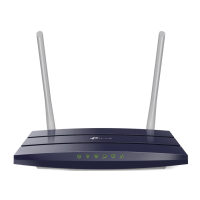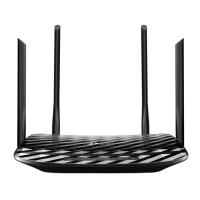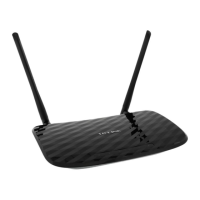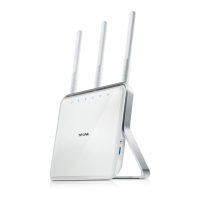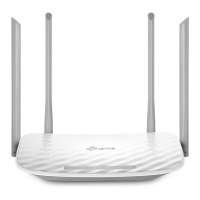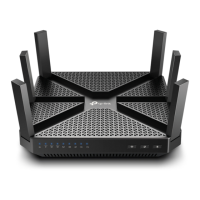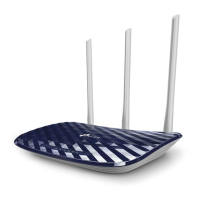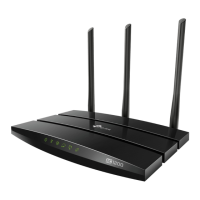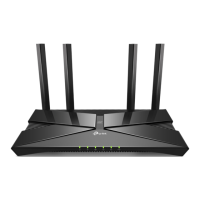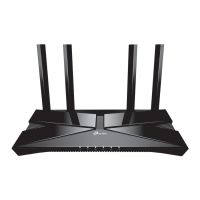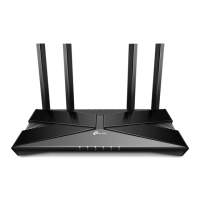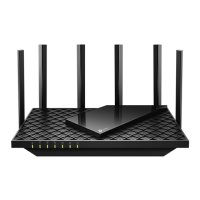Do you have a question about the TP-Link Archer A9 and is the answer not in the manual?
Details the TP-Link router's features and design for SOHO networks, emphasizing performance and ease of use.
Describes the front and back panels of the router, including LED explanations and port identification.
Provides guidelines on optimal placement of the router to ensure proper operation and avoid interference.
Step-by-step instructions for physically connecting the router to the modem and power source.
Guides users through an automated process for setting up the internet connection and TP-Link Cloud service.
Instructions for configuring internet connection settings manually based on ISP information.
Details on configuring IPv6 internet connection types like PPPoE, Dynamic IP, and Static IP.
Steps to set up the router to extend an existing wired or wireless network coverage.
Guide on creating a TP-Link ID to enable remote management and cloud-based services for the router.
Instructions for modifying the email address and password associated with a TP-Link ID.
Explains how an admin account can add or remove other TP-Link IDs as users to manage the router.
Steps to download and use the TP-Link Tether app for managing the router and wireless network.
How to set up a separate Wi-Fi network for guests, customizing SSID and password for security.
Options to control guest network access, allowing or restricting communication between guests and local network.
Instructions for accessing USB storage devices locally or remotely via the router's USB port.
Enables viewing photos, playing music, and watching movies from USB storage on DLNA-supported devices.
Configure rules to block inappropriate content, set time limits, and restrict internet access for specific devices.
Check visited websites and track time spent online by family members, with historical data.
Configure SPI Firewall and DoS Protection to safeguard the network against various cyber threats.
Block or allow specific devices to access the network using a blacklist or whitelist.
Bind IP addresses to MAC addresses to prevent ARP spoofing and other ARP-based attacks.
Set up virtual servers to share local network services like websites or FTP servers on the internet.
Configure port triggering to open external ports dynamically for applications like online games or VoIP.
Expose a PC as a DMZ host to allow unlimited bidirectional communication for specific applications.
Enable UPnP to automatically open ports for online gaming, ensuring seamless connections.
Steps to set up an OpenVPN server on the router and configure the VPN client on a remote device.
Guide to setting up a PPTP VPN server on the router and configuring the PPTP connection on a remote device.
Modify the router's LAN IP address and subnet mask to avoid conflicts or meet network requirements.
Set up the router to support IPTV services, including IGMP proxy and VLAN configuration.
Configure DHCP server settings, including IP address pool and address reservation for client devices.
Configure DDNS to access the router remotely using a domain name instead of a changing IP address.
Manually configure routing entries to direct network traffic to specific destinations.
Customize wireless settings like SSID, password, security options, and enable Smart Connect.
Set up Wi-Fi connections easily using WPS Push Button or PIN methods.
Configure the router's system time, either automatically from the internet or manually.
Turn on or off the router's LEDs, including setting a Night Mode for the LEDs.
Use diagnostic tools like Ping and Traceroute to test connectivity between the router and other devices.
Instructions for updating the router's firmware online or manually to improve performance and security.
Backup current router settings for future use or restore previous configurations and factory defaults.
Schedule automatic reboots for the router to clean cache and enhance running performance.
Change the password for accessing the router's web management page.
Configure password recovery options to reset the login password if forgotten.
Limit router access to specific devices on the LAN using MAC address-based authentication.
Configure access authority for remote devices to manage the router over the internet.
Save system logs locally or send them to a mailbox for troubleshooting network issues.
View and monitor LAN, WAN, and WLAN traffic statistics, including sent and received packets.
Troubleshoot forgotten wireless passwords, including retrieval and reset procedures.
Resolve issues related to forgetting the web management password and password recovery.
Steps to fix problems when unable to log in to the router's web management page.
Guide on using WDS Bridging to extend the wireless network coverage of the root router.
Troubleshoot common problems preventing internet access, such as DNS or IP address issues.
Resolve issues finding or connecting to the wireless network, including password mismatches.
Details the TP-Link router's features and design for SOHO networks, emphasizing performance and ease of use.
Describes the front and back panels of the router, including LED explanations and port identification.
Provides guidelines on optimal placement of the router to ensure proper operation and avoid interference.
Step-by-step instructions for physically connecting the router to the modem and power source.
Guides users through an automated process for setting up the internet connection and TP-Link Cloud service.
Instructions for configuring internet connection settings manually based on ISP information.
Details on configuring IPv6 internet connection types like PPPoE, Dynamic IP, and Static IP.
Steps to set up the router to extend an existing wired or wireless network coverage.
Guide on creating a TP-Link ID to enable remote management and cloud-based services for the router.
Instructions for modifying the email address and password associated with a TP-Link ID.
Explains how an admin account can add or remove other TP-Link IDs as users to manage the router.
Steps to download and use the TP-Link Tether app for managing the router and wireless network.
How to set up a separate Wi-Fi network for guests, customizing SSID and password for security.
Options to control guest network access, allowing or restricting communication between guests and local network.
Instructions for accessing USB storage devices locally or remotely via the router's USB port.
Enables viewing photos, playing music, and watching movies from USB storage on DLNA-supported devices.
Configure rules to block inappropriate content, set time limits, and restrict internet access for specific devices.
Check visited websites and track time spent online by family members, with historical data.
Configure SPI Firewall and DoS Protection to safeguard the network against various cyber threats.
Block or allow specific devices to access the network using a blacklist or whitelist.
Bind IP addresses to MAC addresses to prevent ARP spoofing and other ARP-based attacks.
Set up virtual servers to share local network services like websites or FTP servers on the internet.
Configure port triggering to open external ports dynamically for applications like online games or VoIP.
Expose a PC as a DMZ host to allow unlimited bidirectional communication for specific applications.
Enable UPnP to automatically open ports for online gaming, ensuring seamless connections.
Steps to set up an OpenVPN server on the router and configure the VPN client on a remote device.
Guide to setting up a PPTP VPN server on the router and configuring the PPTP connection on a remote device.
Modify the router's LAN IP address and subnet mask to avoid conflicts or meet network requirements.
Set up the router to support IPTV services, including IGMP proxy and VLAN configuration.
Configure DHCP server settings, including IP address pool and address reservation for client devices.
Configure DDNS to access the router remotely using a domain name instead of a changing IP address.
Manually configure routing entries to direct network traffic to specific destinations.
Customize wireless settings like SSID, password, security options, and enable Smart Connect.
Set up Wi-Fi connections easily using WPS Push Button or PIN methods.
Configure the router's system time, either automatically from the internet or manually.
Turn on or off the router's LEDs, including setting a Night Mode for the LEDs.
Use diagnostic tools like Ping and Traceroute to test connectivity between the router and other devices.
Instructions for updating the router's firmware online or manually to improve performance and security.
Backup current router settings for future use or restore previous configurations and factory defaults.
Schedule automatic reboots for the router to clean cache and enhance running performance.
Change the password for accessing the router's web management page.
Configure password recovery options to reset the login password if forgotten.
Limit router access to specific devices on the LAN using MAC address-based authentication.
Configure access authority for remote devices to manage the router over the internet.
Save system logs locally or send them to a mailbox for troubleshooting network issues.
View and monitor LAN, WAN, and WLAN traffic statistics, including sent and received packets.
Troubleshoot forgotten wireless passwords, including retrieval and reset procedures.
Resolve issues related to forgetting the web management password and password recovery.
Steps to fix problems when unable to log in to the router's web management page.
Guide on using WDS Bridging to extend the wireless network coverage of the root router.
Troubleshoot common problems preventing internet access, such as DNS or IP address issues.
Resolve issues finding or connecting to the wireless network, including password mismatches.
| DSL WAN | No |
|---|---|
| Ethernet WAN | Yes |
| WAN connection type | RJ-45 |
| 3G/4G USB modem compatibility | - |
| Wi-Fi band | Dual-band (2.4 GHz / 5 GHz) |
| Wi-Fi standards | 802.11a, 802.11b, 802.11g, Wi-Fi 4 (802.11n), Wi-Fi 5 (802.11ac) |
| Top Wi-Fi standard | Wi-Fi 5 (802.11ac) |
| WLAN data transfer rate (max) | 1300 Mbit/s |
| Cabling technology | 10/100/1000Base-T(X) |
| Ethernet LAN data rates | 10, 100, 1000 Mbit/s |
| Ethernet LAN interface type | Gigabit Ethernet |
| USB 2.0 ports quantity | 1 |
| Ethernet LAN (RJ-45) ports | 5 |
| Product type | Tabletop router |
| Product color | Black |
| Output current | 1.5 A |
| Output voltage | 12 V |
| Power source type | AC |
| Transmit power | 23 dBmW |
| Antennas quantity | 4 |
| Security algorithms | 64-bit WEP, 128-bit WEP, SSID, WDS, WMM, WPA, WPA-PSK, WPA2, WPA2-PSK |
| Routing protocols | IP |
| Supported network protocols | IPv4, IPv6 |
| Certification | FCC, RoHS, RCM |
| Cables included | LAN (RJ-45) |
| Browser supported | Internet Explorer 11, Firefox 12.0, Chrome 20.0, Safari 4.0, or other |
| Storage temperature (T-T) | -40 - 70 °C |
| Operating temperature (T-T) | 0 - 40 °C |
| Storage relative humidity (H-H) | 5 - 90 % |
| Operating relative humidity (H-H) | 10 - 90 % |
| Depth | 160.6 mm |
|---|---|
| Width | 243 mm |
| Height | 32.5 mm |
